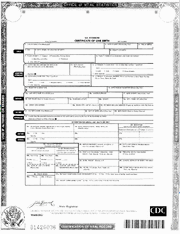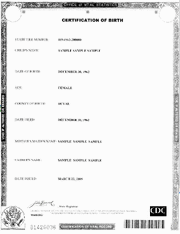
Mary Elizabeth Winblad (1895-1987) birth certificate
A birth certificate is a vital record that documents the birth of a child. The certificate itself usually includes some or all of the following information:
- Birth name
- Date and time of birth
- Sex of the child
- Place and/or location of birth
- Names of the parents of the child
- Occupations of parents of the child
- Birth weight and length
- Name of informant registering the birth
- Date of registration of birth
- A birth registration number or file number
Most countries have statutes and laws that regulate the registration of births. In the United States, it is the responsibility of the mother's physician, midwife, or a hospital administrator to prepare the official birth certificate and file it with the appropriate government agency.
The actual certificate is usually stored with some government office, although the parents of the child and later the child itself are authorized to obtain certified copies or representations of the original birth certificate, which can be used to apply for government benefits, such as passports. The certificate is stamped or signed by the registrar or other custodian of birth records, who is commissioned by the government.
The birth certificate itself is not proof of a person's identity, but only a record stating that a birth occurred at the time, date, and place stated on the certificate. To prove one's identity, a person may need a photo ID, generally issued to an adult.
Birth certificates in the United Kingdom
The registration of births, marriages and deaths in England and Wales started in 1837, but at first there was no penalty for failing to register a birth. Legal adoptions have been registered since 1927.
Births must be registered within 42 days. This can often be done at the hospital, or if not, at the local Register Office. If the parents are married to each other, either parent can register the birth. If not, for the father's details to be recorded, both must go to the Register Office together, or, where the father is unavailable to attend, he may make a statutory declaration acknowledging paternity which the mother may take and vice versa.
Any member of the public may obtain a copy of any birth certificate on payment of the correct fee.
Types of certificates
In the United Kingdom, an individual certificate is not kept on file for each birth. Instead, all births are recorded in registers, and each "full" birth certificate issued is actually a certified photocopy of an entry from the register of births, which is held by the local Register Office and at the General Register Office, London, pursuant to the Births and Deaths Registration Act of 1953. The full certificate is an exact copy of the entry, showing the child's surname, forename(s), date of birth, sex, place of birth, the parent(s) name(s), their address and occupations at the time of registration. Full certificates are required for most legal purposes.
In addition, one can obtain a "short" birth certificate, which is an abstract of the original entry and only includes the surname, forename(s), date of birth, sex, registration district and sub-district in which the birth took place. No fee is chargeable for this certificate at the time of registration.
Birth certificates in the United States
Long forms

Sample of a long form birth certificate
Long forms, also known as certified photocopies, book copies, and photostat copies, are exact photocopies of the original birth record that was prepared by the hospital or attending physician at the time of the child's birth. The long form usually includes parents' information (address of residence, race, birth place, date of birth, etc.), additional information on the child's birthplace, and information on the doctors that assisted in the birth of the child. The long form also usually includes the signature of the doctor involved and at least one of the parents.
In the U.S., the U.S. National Center for Health Statistics creates standard forms that are recommended for long form birth certificate use. However, states are free to create their own forms. These "forms" are completed by the attendant at birth or a hospital administrator, which are then forwarded to a local or state registrar, who stores the record and issues certified copies when requested.
Long forms may become obsolete in years to come, as many states have begun to use Electronic Birth Registration systems. [1] The use of these systems will enable information typically seen on certified copies (long forms) to be available in computer databases that typically issue short form certificates, thus eliminating the need for "hard copy" long form certificates and having all birth information stored in computer databases only. This benefits parents in many ways; registration can be completed via computer at the hospital, meaning that parents can stop by their Vital Statistics office on the way home from the hospital to purchase the birth certificate instantly. It also means that the extra cost for long form certificates will no longer be a factor.
Short forms

Sample of a short form birth certificate (certification of birth)
Short forms, known sometimes as computer certifications, are not universally available, but are cheaper than photocopies and much more easily accessible. Limited information is taken from the original birth record (the long form) and stored in a database that can be accessed quickly when birth certificates are needed in a short amount of time. Whereas the long form is a copy of the actual birth certificate, a short form is a document that certifies the existence of such certificate, and is usually titled a "Certification of Birth" or "Certificate of Birth Registration". The short form typically includes the child's name, date of birth, sex, and place of birth, although some also include the names of the child's parents. When the certification does include the names of the parents, it can be used in lieu of a long form birth certificate in almost all circumstances. Nearly all states in the U.S. issue short forms certifications, on both state and local levels.
Other forms
In addition to short forms and long forms, many registration authorities also have wallet-sized short form birth certifications available, and appostile/exemplified certifications which are hand signed by the registrar and are to be used when being presented before the government of a foreign country. Other registration authorities will even issue commemorative certificates, many of which are legal certifications of birth.
Most hospitals in the U.S. issue a souvenir birth certificate which typically includes the footprints of the newborn. However, these birth certificates are not legally accepted as proof of age or citizenship, and are frequently rejected by the Bureau of Consular Affairs during passport applications. Many Americans believe these souvenir records to be their official birth certificate, when in reality it holds little legal value.
Birth certificates in other countries
Most countries use methods of birth registration similar to those of the United States or United Kingdom. The original birth certificate is stored with a particular agency and copies are issued upon request.
See also
External links
- U.S. Standard Birth Certificate
- Florida Short Form (Computer Certification) Birth Certificate Sample
- Florida Long Form (Photocopy) Birth Certificate Sample
| This page uses content from the English language Wikipedia. The original content was at Birth certificate. The list of authors can be seen in the page history. As with this Familypedia wiki, the content of Wikipedia is available under the Creative Commons License. |